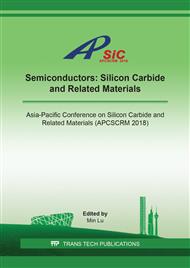[1]
J.J. Sumaleris, J.R. Jenny, A.R. Powell, Bulk crystal growth, epitaxy, and defect reduction in silicon carbide materials for microwave and power devices, Mrs Bulletin, 30(2005) 280.
DOI: 10.1557/mrs2005.74
Google Scholar
[2]
W.J. Choyke, H. Matsunami, G. Pensl, Silicon carbide-recent major advances, Springer(2004).
DOI: 10.1007/978-3-642-18870-1
Google Scholar
[3]
X.X. Guo, Y.M. Zhang, B.L. Fan et al., Quantum confinement effect in 6H-SiC quantum dots observed via plasmon-exciton coupling-induced defect-luminescence quenching, Appl. Phys. Lett. 110(2017) 123104.
DOI: 10.1063/1.4978903
Google Scholar
[4]
D. Nakamura, Simple and quick enhancement of SiC bulk crystal growth using a newly developed crucible material, Appl. Phys. Express 9(2016) 055507.
DOI: 10.7567/apex.9.055507
Google Scholar
[5]
T. Yamashita, T.N aijo, H.M Catsuhata, Haracteristic morphologies of triangular defects on Si-face 4H-SiC epitaxial films, J. Cryst. Growth 433(2016) 97-104.
DOI: 10.1016/j.jcrysgro.2015.10.004
Google Scholar
[6]
N. Sugiyama, A. Okamoto, K. Okumura, Step structures and dislocations of SiC single crystals grown by modified Lely method, J. Cryst. Growth 191(1998) 84-91.
DOI: 10.1016/s0022-0248(98)00124-9
Google Scholar
[7]
K. Takahiro, M. Mitsutoshi, S. Yasuyuki et al., Strain energy analysis of screw dislocations in 4H-SiC by molecular dynamics, Jpn. J. Appl. Phys. 55(2016) 031301.
DOI: 10.7567/jjap.55.031301
Google Scholar
[8]
Y. Yang, J.Q. Guo, O. Goue et al., Effect of doping concentration variations in PVT-grown 4H-SiC wafers, J. Electron. Mater. 45(2016) 2066-2070.
DOI: 10.1007/s11664-016-4378-8
Google Scholar
[9]
J. C. Hu, R.X. Jia, Y.X. Niu et al., Study of a new type nominal washboard-like, triangular defects in 4H-SiC 4 degrees off-axis (0001) Si-face homoepitaxial layers, J. Cryst. Growth 506(2019) 14-18.
DOI: 10.1016/j.jcrysgro.2018.10.026
Google Scholar
[10]
Y.X. Niu, X.Y. Tang, L. Sang et al., The influence of temperature on the silicon droplet evolution in the homoepitaxial growth of 4H-SiC, J. Cryst. Growth 504(2018) 37-40.
DOI: 10.1016/j.jcrysgro.2018.09.022
Google Scholar
[10]
H.P. Iwata, U. Lindefelt, P.R. Briddon, Stacking faults in silicon carbide, Physica B 340(2003) 165-170.
DOI: 10.1016/j.physb.2003.09.045
Google Scholar
[11]
M. Moslemi, M. Razavi, M. Zakeri, et al., Effect of carbon fiber volume fraction on 6H to 4H-SiC polytype transformation, Phase Transit. 91(2018) 733-741.
DOI: 10.1080/01411594.2018.1481214
Google Scholar
[13]
D.W. Feldman, J.H. Parker, W.J. Chokye, Raman scattering in 6H-SiC, Phys. Rev. 170(1968) 698.
Google Scholar
[14]
K. Saravanan, G. Jayalakshmi, B.K. Panigrahi et al., Strain and particle size analysis in ion beam synthesized SiC nanoparticles using Raman scattering studies, Cryst. Res. Technol. 52(2017) 1600391.
DOI: 10.1002/crat.201600391
Google Scholar


